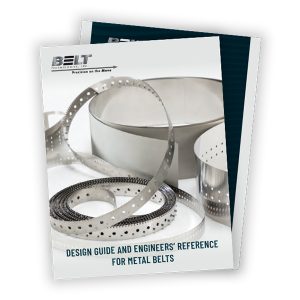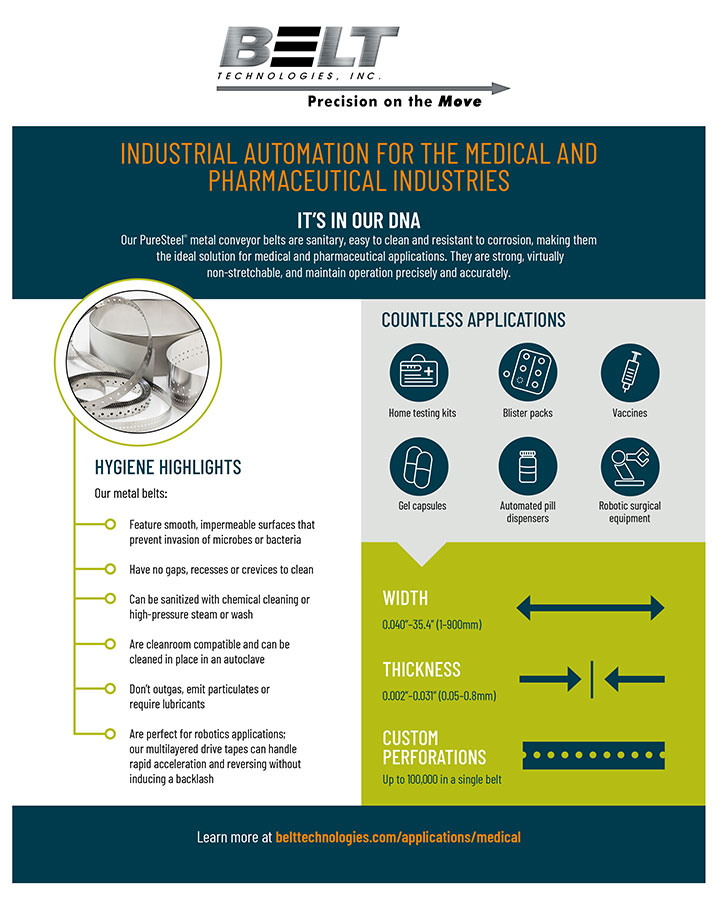Recently, a major automation OEM producing capital equipment for high-tech industries approached Belt Technologies in need of a custom perforated stainless steel conveyor belt for an automated pharmaceutical assembly system.
The client specializes in complex automation; their reputation is built on the reliability and efficiency of the custom equipment they deliver to their customers. This customer had previously worked with Belt Technologies on several projects, including drive tapes for a robotic arm and a flat, horizontal conveyor belt for a visual inspection system. They knew from previous experience that the engineers at Belt Technologies would be the perfect match to help solve their design challenges.
Stainless Steel Is Ideal for Clean Room Environments
This automated system was to be used in the production of disposable medical materials. The belt utilized precise perforations to transport small plastic cups through the system so they could be filled with single-use medical material. Once filled, the belt was to carry to cups through a sealing station, where tamper-evident foil lids would be applied via a heated adhesive process. The entire process would be conducted in a clean room environment in compliance with medical device regulations.
Automated Assembly of Single-Use Medical Supplies Requires Precision Indexing
The main challenge of the customer’s design was precision. The cups needed to be precisely indexed during the filling, sealing, and inspection stages of production. The design specified that the cups would travel on a precision perforated belt that links to three modular assembly units. The belt would have to correctly align at each station. Because the system goes through hundreds of cycles a day, repeatable and accurate positioning would be critical to its success.
Stainless steel conveyor belts are ideal for medical and pharmaceutical manufacturing applications. Studies show that microbes and bacteria are less likely to attach to the smooth, impermeable surface of stainless steel than they are to other belt materials such as plastic and neoprene. Because stainless steel has a high resistance to heat and corrosion, it can be sanitized via a variety of cleaning methods, including high-pressure wash, high-pressure steam, and cleansing chemicals. In addition, stainless steel conveyor belts do not generate particulates and do not require lubrication, making them the best option for clean room applications.
Our expert engineers recommended a wide, stainless steel belt. Our engineers added laser-cut perforations to catch the cups as they are drop-fed from a chute and arranged in a grid formation across the belt. Once the cups pass through the three stages of filling, sealing, and quality inspection, a set of pistons below the belt ejects any cups deemed unsatisfactory. The remaining cups get sent to a second conveyor belt and are queued for tracking.
As automation professionals, the customer’s in-house engineers already had a good idea of what they wanted. The customer needed a metal belt to ensure cleanliness and precise perforations and indexing. They turned to the experts at Belt Technologies for recommendations on holding the cups in place, though they had also considered a vertical carousel with specialized attachments as an alternative method. The final design was selected because it could process a higher volume of disposable cups per cycle and would be a more energy-efficient design.
If your automated assembly application would benefit from the precision and reliable operation of stainless steel conveyor belts, contact the experts at Belt Technologies today.



